Rio Tinto is pleased to announce an important update on flow changes based on recommendations endorsed by the Water Engagement Initiative (WEI) main table members during the Phase 1 process.
As part of Phase 1 of WEI, the main table recommended two flow scenarios. The new hybrid alternative (Alt 6A) endorsed by the main table, reshaped the hydrograph by:
- Dry/normal years: Increased flow release to coincide with actual freshet timing, based on inflows to the reservoir within the existing water budget.
- Wet year: A higher, longer and stepped flow release (“extra water”) to more closely follow the timing and shape of the natural freshet. Choosing this scenario is dependent on adequate water being available.
As we are now in the third year of drought, we are still operating in a “dry year” context. We completed our third monthly snow survey on 1 April. The results, which confirmed the total winter snowpack, showed that it stands at 68% of the long-term average (LTA) for the year.
As of 7 May, the Nechako Reservoir is at 2,790.37 ft, which is about 1.5 ft below the long-term average for this time of year. It’s slightly higher than it was at this time last year, but only because of the proactive measures BC Works took in 2024. These measures included modulating smelter production and importing power. Without these actions, we would be facing significant and potentially extreme challenges now.
With the spring freshet coming into the system and ice melting on the Cheslatta Lake, we propose to implement Alt 6A and increase flow releases from the reservoir by doing a stepped increase to 92 cubic meters per second on 10 and 11 May, which will then reduce to 32 cubic meters per second through a stepped decrease starting 31 May, and remain there until the Summer Temperature Management Program begins in July.
This is different from the status quo, which sees an increase in the release to 49 cubic meters per second during Spring and that is sustained until the Summer Temperature Management Program begins in July. This new flow schedule is not required as part of our regulatory obligations. We are instead proposing to implement it as a voluntary decision based on recommendations received from main table members at the end of the Phase 1 process.
In Vanderhoof, the flows during this period will gradually increase and should reach peak flow between 150 to 200 cubic meters per second.
We will conduct post-monitoring ecological research as part of the pilot year for this flow regime.
To access the main table report visit www.getinvolvednechako.ca
You will also find the hydrographs for dry/normal and wet years below.
If you have any questions, comments or concerns, contact [email protected]
Figure 1: This has been taken from the Phase 1 main table report which can be accessed by clicking here. The orange curve represents the new recommended flow regime and the red curve represents status quo.
